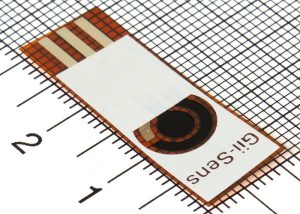It has a central 4mm diameter electrode of the material surrounded by a anulus of the same material (see photo).
Crucial to the sensor is a ‘pyrene-appended boronic acid’, developed elsewhere, whose molecules attach to the carbon surface at one end, and react with lactic acid at the other (they also react with glucose).
Measurement are made with the sensor immersed in a buffer liquid.
“When lactate binds to the sensor, it causes a change in the quantum capacitance of the carbon foam,” according to Integrated Graphene. “The foam therefore detects low levels of lactic acid, without consuming it, by measuring changes in electrical charging.”
The capacitance is due to a double-layer capacitor that forms from cations and anions. It is modified, speculates the team, as charges redistribute when the lactic acid attaches.
The measurement is by electrochemical impedance spectroscopy – measuring current and voltage amplitude and phase at different frequencies – then calculating the capacitance when the system is approximated to a series RC circuit.
Capacitance varied from 60 to 110μF, with a useful log relationship with lactic acid concentration between 70 to 110μF.
A drawback is that it only works in slightly acid conditions (~4 pH) and not in the body’s 6-7 pH, and it is not particularly reversible – both of which might be amenable to modification of the receptor molecule, according to the research team.
The work is published in ACS Sensors as ‘Pyrene-appended boronic acids on graphene foam electrodes provide quantum capacitance-based molecular sensors for lactate‘, which can be read in full without payment.

